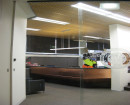HOWQUA UNITED/GREAT RAND MINE SITE
HOWQUA HILLS TRACK HOWQUA, MANSFIELD SHIRE
-
Add to tour
You must log in to do that.
-
Share
-
Shortlist place
You must log in to do that.
- Download report
Statement of Significance
What is significant?
The Howqua United Gold Treatment Works consists of the remains of pyritic roasting furnace with an intact brick chimney stack. Near the roasting furnace is a battery site which was powered by a waterwheel (which, at 63ft diameter, was reputedly the third-largest ever to operate in Victoria. A 1.0km long inclined tramway connects the battery site to the mine workings (a small glory hole or open stope.
How is it significant?
The Howqua United Gold Treatment Works is of historical, scientific and archaeological importance to the State of Victoria.
Why is it significant?
The Howqua United Gold Treatment Works is historically and scientifically important as a characteristic and well preserved example of an important form of gold mining. When the greater part of the gold in some ores is contained in its pyritical contents, the gold is very difficult to extract. From the nineteenth century miners experimented with various metallurgical (or heat treatment) processes to unlock gold from heavily mineralised ore. Evidence of these metallurgical processes, such as the one carried out by the Howqua United Company during the late 1890s, are extremely rare in the State of Victoria.
The Howqua United Gold Treatment Works is archaeologically important for its potential to yield artefacts and evidence which will be able to provide significant information about the technological history of gold mining.
[Source: Victorian Heritage Register]
-
-
HOWQUA UNITED/GREAT RAND MINE SITE - History
Heritage Inventory History of Site:
The Howqua United GMC was formed in 1883 to work a lease lower down the ridge than the Mountain Chief. Driving the 20-head Howqua United battery was a waterwheel - christened the Hanney - which at 63 ft diameter was reputedly the largest in the southern hemisphere at that time and the third-largest ever to operate in Victoria. The water for the wheel was supplied by a race passing through Tunnel Spur to a supply point about 5 km upstream from the battery, which was situated on the flat below the Howqua United mine. Trial crushings produced poor yields, and the mine closed down within a year.The Howqua Hills GMC reworked the Howqua United mine from 1886 until the early 1890s, for only small returns. The remaining portion (most of the 20 heads had been removed - perhaps five remained?) of the Howqua United battery was reconditioned and re-utilised when the Mountain Chief mine was reworked for a short time from 1892. Additional plant was constructed at this time, in the form of a substantial furnace and tall brick chimney stack, on Fry's Flat.The Mountain Chief and Howqua United leases were taken up by the Great Rand Proprietary GMC in 1902. Commencing with £32,000 capital, the company erected a 30-head battery on the site of the old Howqua United battery, once again employing the old Hanney waterwheel. The high-level water race which fed the wheel was reopened and extended, but gave insufficient water to successfully run the battery. A hopper, Krupp ball mill, classifier and concentrating tables were installed and operated in conjunction with the ore furnace and stack of the early 1890s. As before, the mine gave inconsistent yields and operations ceased in 1903. The Hanney waterwheel was dismantled and removed in 1916.
References:
Christie, pp. 34, 46
Wylie (1987), pp. 45-6
Wylie (1988), p. 5Heritage Inventory Description
HOWQUA UNITED/GREAT RAND MINE SITE - Heritage Inventory Description
Features of the Howqua United/ Great Rand mine site are an open cut, the formation of a double acting tramway, water race and tunnel, battery site and roasting furnace.
Heritage Inventory Significance: National Estate. The site has scientific significance because of its rarity and intactness.
Heritage Inventory Key Components: Open cut - Partially collapsed (or filled) open cut which opens out into a stope. Short haulage adit at entrance to (western end of) open cut. Double-acting tramway - A 1km-long tramway runs from the open cut to a battery site on the bank of Howqua River. Diversion tunnel/water race - Water still passes through the Tunnel Spur diversion and the water race is traceable along the southern side of the river. Sections of the race have been removed by the construction of a track. The race is very visible at the Sheepyard Flat Camping Area. Battery site - The Howqua United/Great Rand battery site is obscured by high blackberry bushes, the only visible feature being a tailrace running to the river. Roasting furnace - Intact square brick stack, approximately 25 ft high. At the rear of the stack is a partly collapsed 9ft-long brick flue, running along the side of which are the foundations of the roasting furnace. Although largely obscured by rubble and vegetation, there appear to be at least seven lines of brickwork, each line a single brick wide.
Archeological Potential: Yes.
-
-
-
-
-
HOWQUA UNITED GOLD TREATMENT WORKS
 Victorian Heritage Register H1279
Victorian Heritage Register H1279 -
HOWQUA UNITED/GREAT RAND MINE SITE
 Victorian Heritage Inventory
Victorian Heritage Inventory
-
-







